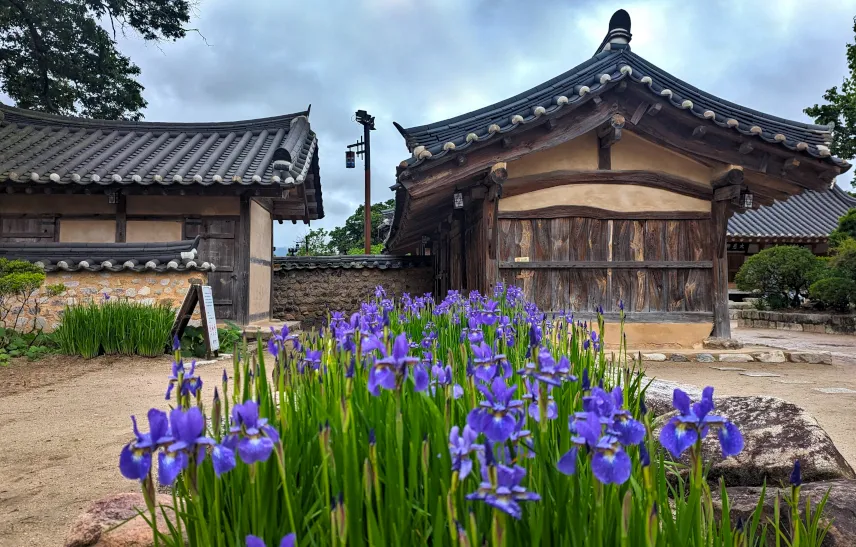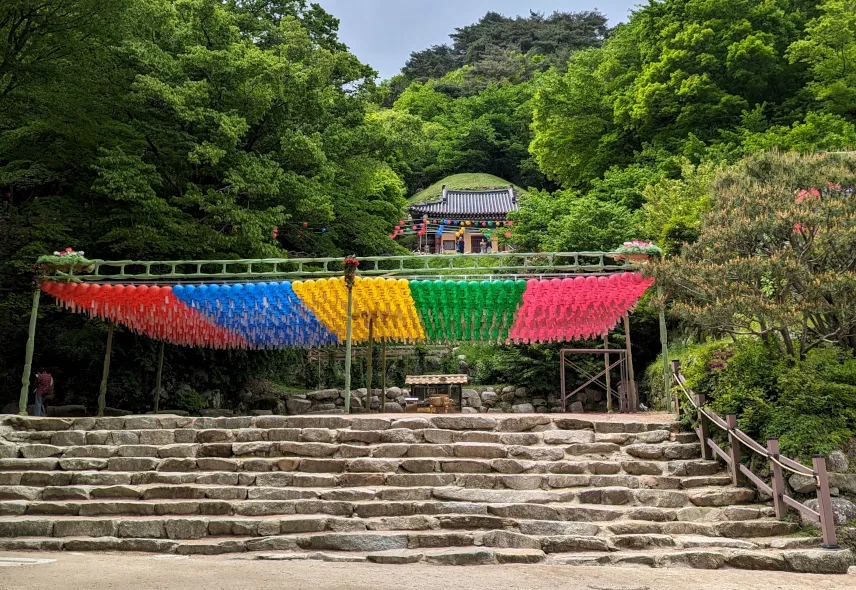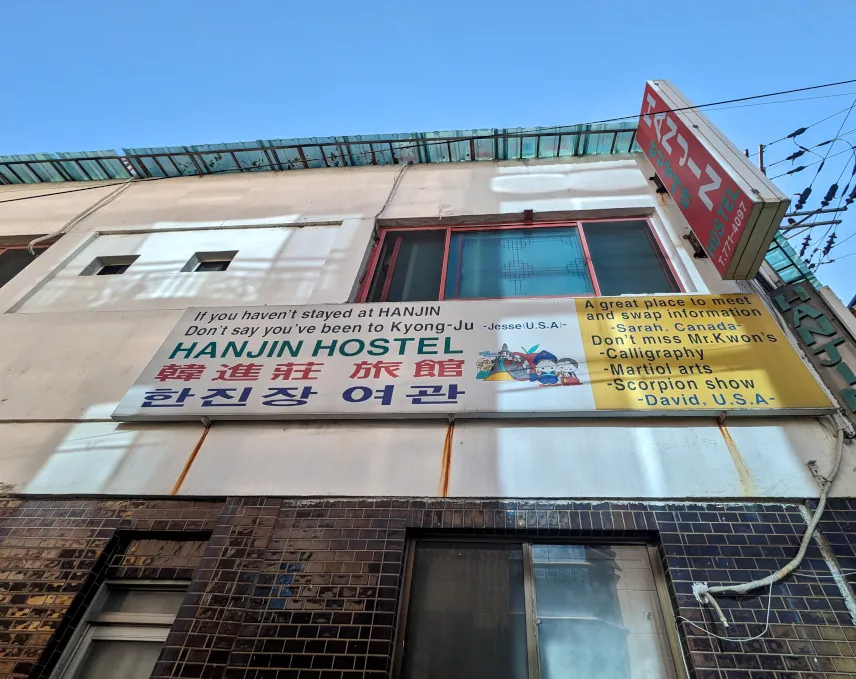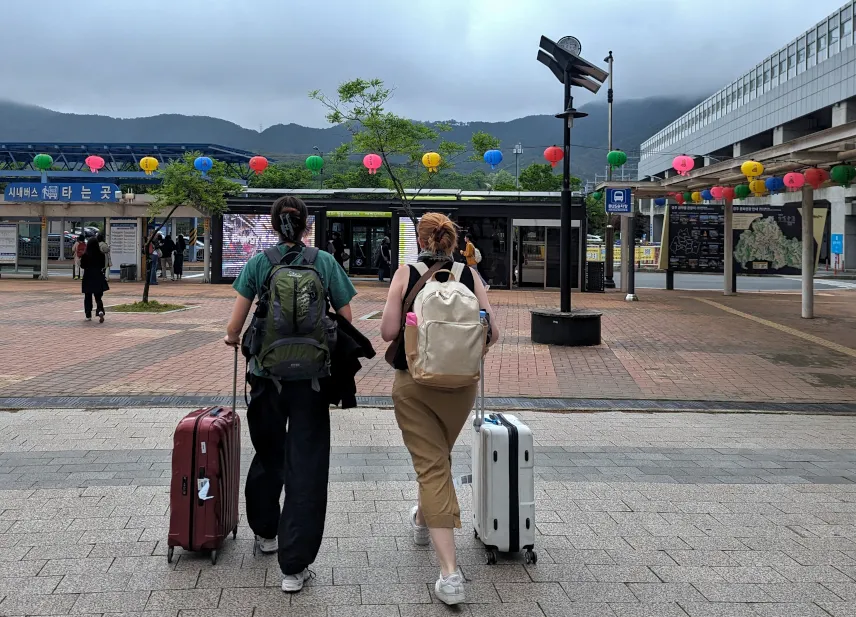
2 Day Gyeongju Itinerary & Backpacking Guide (+ Map)
TL;DR
You have two days in Gyeongju, we have the perfect Gyeongju itinerary for you!
There are two things we enjoy while travelling: History and free stuff. Gyeongju in Korea has them both! Gyeongju used to be the capital of the Silla kingdom (basically Korea) and is hence chuck full of historic sights – many of which are listed as a UNESCO World Heritage Site. Still, the vast majority does not charge any entrance fee as of today – amazing!
Of course, we instantly fell in love with Gyeongju. So without further ado, here’s our 2 day Gyeongju itinerary as well as a quick Gyeongju travel guide. As always, it’s efficient as well as budget-friendly 😉
Gyeongju 2 Day Itinerary
- Get a T Money card to stay mobile.
- Get an eSIM card to stay connected.
- Download Naver Map for navigation.
- Check out our complete South Korea itinerary.
Day 1 – Historical Sights around Central Gyeongju
Morning – Daereunwong Tomb Complex, Gyeongju Eastern Historic Site & Gyeongju Gyochon Traditional Village
Start your first day in Gyeongju at what we consider to be the city's highlight: The Daereunwong Tomb Complex. They are a complex of ancient burial mounds from the Silla period which form a very unique landscape.

Exit the Tomb Complex towards the south to get to the Gyeongju Eastern Historic Site. There are several sights to explore here including more burial mounds. The highlight here is Cheomseongdae Observatory, the oldest surviving observatory in Asia.

From here, it’s an easy walk to Gyeongju Gyochon Traditional Village which is also called Gyeongju Hanok Village. It is comprised of several houses which are built in the traditional Korean Hanok style. We especially enjoyed that some of the houses are free to enter.
We particularly liked the House of Rich Man Choe which was a recommendation from our lovely host as well as the Gyodong Beopju winery right next to it.

Head to Woljeong Bridge next. The view across the Namcheon River towards the bridge is super picturesque and so are the green and red decorations on the bridge.

Afternoon – Gyeongju National Museum & Temples
We walked further along the northern bank of the river and explored some more sights of the Wolseong District Historic Site. We especially liked the Banwolseong (Half-moon Fortress), the Gyerim Forest, and the views across the river.

Next, we headed down the path towards the Gyeongju National Museum. If you know us, you know that we love two things: great museums and free things – the Gyeongju National Museum was both! The bilingual exhibition was extremely well presented.
The main collection is devoted to relics of the Silla kingdom. You can also admire some of the items which have been found in the burial mounds around town. Other highlights include the Silla Art Gallery with Buddhist art and the Divine Bell of King Seongdeok.
We personally loved the Mille Silla, an open storage facility where you can learn loads about the collection, preservation, and restoration efforts of the museum.

Our lowlight of the day is right next door: The Donggung Palace and Wolji Pond. It was in all the Gyeongju travel guides we had read but if you ask us, you might as well skip it. There’s a lake as well as three small reconstructed lakeside pavilions on the grounds.
It was the only sight of the day we had to pay a (small) entrance fee for. Many people visit in the evening. Supposedly this palace is nicer with the illumination.

We decided to loop back via the Hwangnyongsa Temple Site as it was another recommendation from our host. During the Silla Era, the temple was the nation’s largest temple and housed the bulk of the country’s major Buddhist treasures. It was built in 553. Nowadays, only remnants of the original structures are left. For a small fee, you can visit the Hwangnyongsa History & Culture Hall where you can find a reconstruction of the impressive nine-story pagoda.

When you follow the footpath from the Hwangnyongsa Temple Site, you end up at Bunhwangsa Pagoda. It was one of the four main temples of the Silla dynasty. The pagoda was established in 634 which makes it the oldest dated pagoda from the Silla Kingdom. It is considered as a National Treasure of Korea.

Evening – Street Food & Illuminations
Jungang Night Market might not be the most impressive night market you have ever seen, but if you ask us, this is the best spot for street food in Gyeongju. It’s within the halls of Jungang Market so you’re independent of the weather.

As we promised, here’s a great free spot to see historic sights with illuminations: The Gyeongju Eupseong Fortress. It’s a city fortress wall which was rebuilt in the early Joseon Dynasty. It’s open 24/7 and you can even walk parts of the wall.

Day 2 – Day Trip to Bulguksa Temple and Seokguram Grotto
Morning – Bulguksa Temple and Seokguram Grotto
Hop on the bus (line 10 or 11) to explore one of the main sights of Gyeongju, the Bulguksa Temple. It was built in 751 and is considered as a masterpiece of the golden age of Buddhist art in the Silla kingdom. It contains six National Treasures and is listed as a UNESCO World Heritage Site.
The complex is quite large including
- An impressive staircase that leads to the inside of the temple compound.
- Two pagodas.
- Two courts: Daeungjeon with the main hall and Geungnakjeon with the hall of paradise.
There are loads of things to explore on the premises so allow for enough time.

Next, hop on a bus to Seokguram Grotto.
Seokguram Grotto is the representative cave temple of Korea. Inside, you can find a beautiful granite Budhha which is considered to be the highlight of Silla’s Buddhist art. Unfortunately, you are not allowed to take pictures inside the grotto so you have to go and check it out yourself.

Afternoon – Modern Gyeongju
The bus ride back to Gyeongju will take roughly 30 minutes. We recommend to spend the afternoon exploring modern Gyeongju.
Hwangnidan Street is the main street of Gyeongju and is filled with cafes, restaurants, and shops.
Unlike in many other Korean cities, there’s no dedicated cultural village in Gyeongju. Still, you can find loads of street art in the alleys around Hwangnidan Street. This is also where you can find a bazillion of the cutest cafes and restaurants ever.

Evening – Dinner Options
Dinner options around Hwangnidan Street are amazing. Still, we couldn’t help but recommend Ddobagi Bistro right next to our accommodation.

Quick Gyeongju Backpacking Guide
Gyeongju Tourist Map
What is Gyeongju Known for?
Gyeongju is mostly famous as the old capital of the ancient kingdom of Silla which covered almost all of recent Korea. The region of Gyeongju is on the UNESCO World Heritage List. It is also known as “museum without walls”.

Is Gyeongju Worth Visiting?
If you ask us, Gyeongju is the single best place in Korea to visit when you’re a history lover.
Even if you’re not into history at all, you can do some lovely hikes in the area.
Hiking in Gyeongju
According to our host, Mt Namsan offers the best hikes in Gyeongju. You can take bus no. 11. to the Gyeongju National Park Samneung Visitor Center. From here, you have multiple hiking options including royal tombs, temples, as well as rock-carved Buddhas.
Is Gyeongju Walkable?
Confession: We have walked (almost) the whole day 1 of our Gyeongju itinerary. If that’s too much walking for you, you can also rent a bike.
Where We Stayed in Gyeongju
We stayed at Han Jin Hostel and enjoyed it a lot. While the rooms are quite basic, the location is amazing and the owner an absolute gem!

Is 2 Days Enough for Gyeongju?
In case you’re wondering how many days in Gyeongju you need: We think two days is the absolute sweet spot to visit Gyeongju. You can comfortably see all the sights in the centre on day 1 and go on a day trip to Bulguksa Temple on day 2.
If you’re into hiking, you might need another day to explore the area around Mt. Namsan.
Busan to Gyeongju Day Trip
If you only have one day in Gyeongju, a day trip from Busan is a convenient option:
Where is Gyeongju Located?
Gyeongju is located on the east coast of South Korea around an hour’s drive north of Busan.
How to Get to Gyeongju
The Gyeongju bus terminal is right in the centre of town and should be within walking distance from your accommodation.
Don’t let yourself be fooled by the location of Gyeongju train station on Google Maps. The station was moved out of the city centre a couple of years ago (we have marked the current location on our map). The bus to the city centre is clearly marked and signposted in English. Of course, you can pay with your T Money card.
Seoul to Gyeongju
Seoul to Gyeongju Bus |
Seoul to Gyeongju Train |
| ~ 3.5 hours, ~ 25$ | ~ 3 hours, ~ 46$ |
We opted for the bus because it was significantly cheaper. Also, the bus station in Gyeongju was practically right next to our accommodation.

Busan to Gyeongju
Busan to Gyeongju Bus |
Busan to Gyeongju Train |
| ~ 60 minutes, ~ 6$ | ~ 30 minutes, ~ 7$ |
If you ask us, the train from Busan to Gyeongju is the better option. It is faster and the train station in Busan is much more central than the bus station. The trains leave super frequently throughout the day. We just popped into the station and bought a ticket for the next one.

What to Eat in Gyeongju
If you only try a single dish in Gyeongju, make it Gyeongju bread, a small pastry with a filling of red bean paste.
Gyeongju Restaurants
A quick note on restaurants in Gyeongju: The majority of restaurants in South Korea are only open for lunch and dinner. Most of them are closed between 2 pm and 5 pm. Keep this in mind when planning your day!
Disclaimer: This post contains affiliate links. If you use these links to buy something we may earn a commission. You would help us a lot if you do so. Thanks.